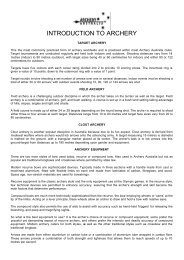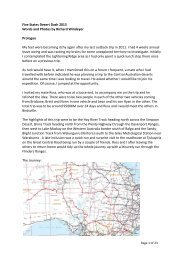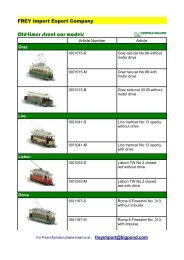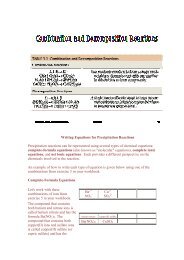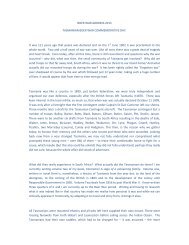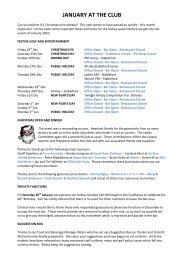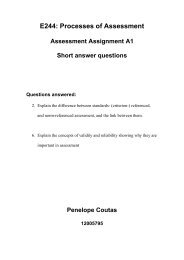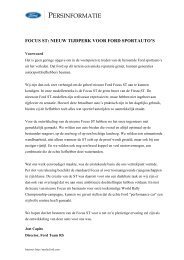Morsecodians Messenger Vol 3 Issue 9 1/6/2008 - iiNet
Morsecodians Messenger Vol 3 Issue 9 1/6/2008 - iiNet
Morsecodians Messenger Vol 3 Issue 9 1/6/2008 - iiNet
You also want an ePaper? Increase the reach of your titles
YUMPU automatically turns print PDFs into web optimized ePapers that Google loves.
MORSECODIANS<br />
MESSENGER<br />
The official newsletter of the <strong>Morsecodians</strong> Fraternity of Western Australia (Inc.) Editor: Larry Rice<br />
<strong>Vol</strong>ume 3 <strong>Issue</strong> 9 08 9276 6936 June <strong>2008</strong><br />
<strong>Morsecodians</strong> Keeping Morse-code<br />
Alive<br />
Auckland NZ Telegraph Office October 1948<br />
Royal Show 27th Sept—9th Oct <strong>2008</strong><br />
<strong>Vol</strong>unteers required for duty at our major event of the year.<br />
Talkers, Receivers, Senders— have a go, great fun.<br />
Give your name to Ken:- 9450-5069.<br />
Thanks to API, our sponsor.<br />
NEXT MEETING<br />
Hyde Park Hotel<br />
16th June <strong>2008</strong> 10 am<br />
STOP PRESS !!!<br />
This is our LAST meeting at the Hyde<br />
Park Hotel. The room we use is being<br />
demolished to make way for a<br />
restaurant, so no more meetings here<br />
beyond June. Please try and attend.<br />
Members and visitors welcome.
‘The Bar’ – A Vital Link to The North<br />
by Double Click<br />
From soon after its completion in 1893, the number 6 coastal<br />
telegraph line from Perth to Broome and then on to Wyndham as<br />
number 8 was susceptible to the effects of sea mists, cyclone<br />
damage and traffic congestion.<br />
These problems were eased in 1912 when a new line was built<br />
on an inland route through Mullewa, Meekatharra, Mundiwindi<br />
and Nullagine to Marble Bar where it was joined to the existing<br />
line to Broome. This line was designated No. 65 and No. 6 was<br />
then terminated at Marble Bar which became a repeater station<br />
and the most important switching station in the North. Both<br />
these lines were operated on the duplex principle. In 1926 that<br />
section of No. 65 from Marble Bar to Warroopna, just south of<br />
the La Grange telegraph station, was moved further inland. This<br />
bypassed Condon and cut out a particularly bad section of the<br />
existing line.<br />
Power for the landline at Marble Bar was provided by forty 6 volt<br />
accumulators and four banks of these were on hand, which were<br />
rotated on a regular basis from, in service, to re-charge, to stand<br />
-by. Re-charging was done by a converted 4 cylinder Meadows<br />
marine engine with three small single cylinder engines with attached<br />
generators available for emergency use.<br />
Morse communication was further enhanced in 1945 when most<br />
post offices from Carnarvon north were additionally equipped<br />
with type 3BZ radio transmitters and receivers. (see appendix<br />
A). Although these radios were low powered, and initially only<br />
intended for emergency short range use, they could be worked<br />
satisfactorily over longer distances when conditions were<br />
suitable. Marble Bar, Onslow, Roebourne, Port Hedland,<br />
Learmonth and Wittenoom were able to work by Wireless<br />
Telegraphy (WT) direct with Perth Chief Telegraph Office (CTO)<br />
on 9 megs. However by midday conditions usually became too<br />
noisy and that frequency had to be abandoned. A change to 2<br />
megs was sometimes successful. Inter-office contact was<br />
usually on 5.5 megs. Changing frequencies was done by means<br />
of a switch in the post office which brought a different length<br />
aerial into use.<br />
The Post Office in 1953 — burnt down in 1958<br />
In 1949, to ease traffic congestion on the landline, a radio<br />
telegraph circuit using powerful 260 watt Temco transmitters<br />
was established between Perth and Broome. Rhombic aerials,<br />
which produced strong directional signals, allowed consistent<br />
working by WT between Broome and the CTO. Byford was the<br />
receiving station for all Post Master Generals Department (PMG)<br />
incoming radio signals which were then relayed to the CTO.<br />
Outgoing signals were transmitted via the Wanneroo station.<br />
Both these locations being outer Perth suburbs.<br />
The circuitry involved with the two duplex lines was unusual if<br />
not unique in that they could be switched to enable individual<br />
stations to work with the CTO at the same time. ie Broome could<br />
be transmitting to the CTO on 65 while Pt Hedland was receiving<br />
from the CTO on 65/6. It was a very versatile arrangement and<br />
when combined with the use of the radios provided multiple<br />
options in the event of cyclones, line faults or heavy traffic. The<br />
importance of the telegraph in those times could not be overestimated.<br />
Until the late 1950s there was no public voice communication<br />
beyond Carnarvon or Meekatharra. Morse telegraphy was<br />
the life blood of the north.<br />
Page 2<br />
Because of its inland position, Marble Bar usually escaped the full fury<br />
of cyclones and was ideally situated to provide assistance when line<br />
damage or faults occurred. Col Hopkins who was Postmaster at<br />
Marble Bar from 1952 until 1955 and experienced several incidents<br />
where the coastal line was extensively damaged by cyclonic action,<br />
said: ‘It was times like these that the radio at Marble Bar really came<br />
into its own’. Col recalled a particularly severe cyclone which hit<br />
Onslow on the evening of 22 nd March 1953. The following day the<br />
Onslow Postmaster took a party along 4 miles of the telegraph line.<br />
Travelling with great difficulty, he found at least 25 poles, which were<br />
either down or badly damaged. Returning to Onslow they concentrated<br />
their efforts on repairing the radio aerials, which were broken in<br />
several places, and the supporting poles were also damaged. By 1pm<br />
the wind had subsided sufficiently for the masts to be climbed and<br />
adequate repairs made, which enabled WT contact with Marble Bar.<br />
As Roebourne and Port Hedland had also suffered line damage it was<br />
necessary for Marble Bar to hand repeat all traffic for these offices as<br />
well as for Wittenoom. The telegraph line north of Onslow was<br />
repaired after 4 days but Onslow was worked by radio for 2 weeks.<br />
Just a month after the devastation at Onslow another cyclone hit Port<br />
Hedland severely damaging the line. With Carnarvon unable to use its<br />
radio because of local interference and with Port Hedland’s radio<br />
signals too weak to reach Broome, Marble Bar again assisted by<br />
repeating for Port Hedland, Roebourne, Onslow and Wittenoom.<br />
The operating table in 1953<br />
A similar operation was necessary during the October 1952 atom<br />
bomb tests. Both circuits were needed by Mt Potter which left those<br />
offices between Marble Bar and Carnarvon isolated. On this occasion<br />
Marble Bar received traffic by WT from those affected offices and<br />
hand repeating it to Broome on number 65 for further retransmission<br />
to Perth by WT.<br />
Marble Bar really was ‘A Vital Link To The North’.<br />
Appendix A - The type 3BZ radios were ex ‘Coast Watchers’, a unit<br />
set up in New Guinea to monitor and report Japanese ship movements<br />
during WW11. The Japanese would often land armed parties to try<br />
and wipe out these units so it was necessary for the ‘Coast Watchers’<br />
to be highly mobile. For this reason the heavy radios were in two parts<br />
– a transmitter and a receiver. In addition to the radios, two 6 volt<br />
accumulators were required and a 3 hp motor and generator, plus of<br />
course fuel, food and survival gear. Up to 20 porters were<br />
necessary when a hurried move had to be made.<br />
3BZ Receiver 3BZ Transmitter<br />
Pic source: http://www.qsl.net/vk2dym/radio/3BZa.htm
Page 3<br />
Alice Springs Heritage Week <strong>2008</strong> by Allan Greenslade<br />
A popular feature of the Alice Springs Heritage week activities, the old Telegraph Station was opened for traffic between<br />
Alice Springs and the Powerhouse Museum Sydney from 18th-27th April <strong>2008</strong>.<br />
L-R Rex Rutherford, Allan Greenslade, Phil McGrath, Bob Lillis<br />
Rex was accompanied by wife Joan, and Phil by his daughter Karen. Our thanks goes to these ladies for their unfailing<br />
support and assistance throughout (including the frequent “coffee runs”!) In addition, they proved to be most effective in<br />
selling telegrams to the visitors.<br />
The Rangers too were extremely helpful and our gratitude was expressed in a small presentation given by Phil McGrath<br />
on behalf of us all. The local TV station made a feature of our activities and included an interview with Rex Rutherford.<br />
The resultant short documentary was well done and was shown on evening television in Alice Springs the same day.<br />
Visitors were consistent throughout each day with brief busy periods as tourist coach groups passed through. Almost<br />
without exception the visitors, both local and overseas, were very interested in what they saw and the comments in the<br />
Visitors Book were most complimentary.<br />
The overall number of messages handled was 1324, slightly in excess of the previous year.<br />
Included in this figure are the telegrams that were transmitted to W.A. on the evening of 24th April. 78 messages were<br />
sent to Armadale, staffed by Ken Knox, Peter Edmunds and Charlie Spalding and 67 were received by Col Hopkins at his<br />
home with Terry Keays and Alan Jolley. The total [145] was slightly less than last year [163].<br />
Col Hopkins and<br />
Alan Jolley pictured<br />
receiving Alice<br />
Springs traffic at<br />
Col. Hopkins home.<br />
THE CHANGE OF CODE by Double Click<br />
Most of you will recall your telegraph operating days when<br />
we used ‘AR’ (.-.-.) to signal end of message, ‘EEK’ (. . -.-)<br />
to acknowledge or confirm and ‘EI’ (. ..) when repeating<br />
cipher or figures.<br />
These signals were of course a carry over from pre-1897<br />
days when American Morse was used on all colonial circuits<br />
east of Eucla. The Swan River Colony was the only colony<br />
which used International Morse Code from inception. During<br />
1896 a resolution was passed at an Inter-Colonial Post &<br />
Telegraph conference that International Morse Code was to<br />
be used on all colonial circuits from 1 st July 1897. This was<br />
to conform with most other countries which were using this<br />
code. The American Morse was largely abolished in Europe<br />
in 1851 and the International Morse Code was substituted.<br />
North America, however, continued to use Samuel Morse’s<br />
original code.<br />
It is widely believed that the new code was devised in 1851<br />
by Karl August Steinheil, a German, in consultation with<br />
interested parties from several other European countries.<br />
However another German, Friedrich Clemens Gerke, also<br />
lays claim to inventing the code and that it was first used<br />
with telegraphy between Hamburg and Cuxhaven in 1848.<br />
In 1865, after some minor changes, it was finally ratified by<br />
the International Telecommunications Union as International<br />
Morse Code.<br />
But why was the code changed in the first place?<br />
Some of the reasons suggested make interesting reading.<br />
However which one is right?<br />
One reason for the change was that the American Morse<br />
with its dot patterns, spaces, and dashes of differing lengths<br />
was very complicated. The Germans, being sticklers for<br />
efficiency, opted for the new code even though it was some<br />
20 percent slower.<br />
Another reason was that some German letters with<br />
diacritical marks, those dots or wavy lines above some<br />
letters, could not be transmitted. The new code included<br />
signals for these letters, however they were very seldom<br />
used.<br />
A third reason was that capacitance, that phenomenon<br />
which causes an electrical charge to be stored momentarily<br />
on long submarine cables, prevented signals from being<br />
transmitted rapidly and made the transmission of some<br />
American Morse signals almost impossible. More so with<br />
double key operation.<br />
A more recent fourth suggestion that Wireless Telegraphy<br />
was responsible for the change does not seem valid, as WT<br />
had not been invented in 1851. However American Morse<br />
did eventually prove unsuitable for WT when even mild<br />
interference was present.<br />
It would seem that capacitance was the most logical reason<br />
behind the change. However J B Calvert, the author of a<br />
document on The Electromagnetic Telegraph, does not<br />
agree and says the changes were more likely made because<br />
of the German influence. What do you think ?<br />
Page 4<br />
Morse key remembrance for HMAS Sydney<br />
An old morse key was dropped into the Indian Ocean<br />
recently as part of a remembrance service of the sinking of<br />
HMAS Sydney in 1941.<br />
The morse key was used by the father of South Australian<br />
man Bob Honor in his trade as a telegraphist.<br />
The crew of modern-day HMAS Sirius collected the key while<br />
in Adelaide over Easter.<br />
The ship docked in Perth then crossed the site where the<br />
Sydney rests on the sea bed before resuming its journey to<br />
Singapore.<br />
Mr Honor is pleased that the morse key will be dropped into<br />
the ocean as part of the service remembering his late father<br />
and the others who died when the Australian ship was sunk<br />
by German fire.<br />
"It was something that was directly associated to him, it<br />
wasn't a scarf, it wasn't a flat-topped naval hat, it wasn't<br />
anything of that nature - this was his, he learnt his morse<br />
code on it," Mr Honor said.<br />
Source: http://www.abc.net.au/news/stories/<strong>2008</strong>/03/28/2202227.htm<br />
AN INCREDIBLE LEGACY—<br />
THE KEYBOARD<br />
Today’s standard keyboard layout—is the century-old legacy<br />
of one Christopher Latham Sholes who had issued a patent<br />
in 1878 and is credited with inventing the first typewriter to<br />
be commercially successful.<br />
The problem is, Sholes’s keyboard layout is so ill-suited to<br />
contemporary uses that even a random scrambling of keys<br />
could produce a sharp increase in keyboard-operator<br />
throughput.<br />
The reason that this layout was used, was to purposefully<br />
slow down operators.<br />
In Sholes’s original typewriting machine of 1872, he relied<br />
on gravity alone to return the key arms to their home<br />
positions. The keys were suspended in a circular nest of<br />
wires beneath the platen and too fast an operating speed<br />
invariably caused them to jam up.<br />
52% of all English language is typed on the top row of<br />
letter-keys, and the top row (except for an extra Q, U and<br />
O) is extracted from none other than the word<br />
“TYPEWRITER”.
TELEGRAM SERVICE CEASES IN THAILAND<br />
The telegram, introduced in Thailand by King Rama-V<br />
133 years ago, ceased as of May 1 <strong>2008</strong>.<br />
The sound of dots and dashes from a telegraph device using<br />
Morse-code is resonating through the hall of Bangkok CTO in<br />
a show to commemorate the end of the country’s telegram<br />
service which saw several thousand people bid it farewell.<br />
On the final day parents, teenagers, the elderly and first-time<br />
users packed the headquarters of Thailand Post Plc in Bang<br />
Rak district, waiting for hours to send final telegrams to<br />
friends, family and loved ones, and to buy souvenirs.<br />
The public enthusiasm was overwhelming, said Wiboon<br />
Sereechaiporn, assistant vice-president of the corporate and<br />
marketing communications department.<br />
"The last chapter of 133 years of the Thai telegraph will be in<br />
the memory of Thais forever," was the last message sent by<br />
telegraph, by the Thai Information and Communications<br />
Technology Minister. It was sent to 40,000 people who had<br />
reserved a final telegram, according to the Thai News Agency.<br />
The service peaked in 1995, when 12 million telegrams were<br />
sent across the country.<br />
Both Thai people who grew up in the prosperous telegraph<br />
era, and young children who never knew what a telegram<br />
was, flocked to the post office to send their last telegrams.<br />
“I’m sending a telegram to my nephew telling him to study<br />
hard. This telegram will remind him we once used to have<br />
such a kind of service,” said Sopon Panitbutr Telegram user.<br />
With its long years of service, the end of the telegram in<br />
Thailand has down heartened many telegram officers.<br />
“To be honest, I don’t want to see the end of the telegram. I<br />
have been working here for three decades and I expect to be<br />
retired as a telegram officer. But it seems like I have to start<br />
at zero again at the almost-retired age,” said Pramin<br />
Sathapornsuk—Telegram Officer.<br />
Thai telegram form<br />
Page 5<br />
From the archives<br />
well - maybe some …!!<br />
from: Tom Twomey, class of ‘33.<br />
“You remember, of course, old fellow Morse<br />
Who for years kept us under his thumb;<br />
Who filled us with sound till our heads went around<br />
Like a swarm of bees in a drum.<br />
You remember the men who took him by pen<br />
In the years before automation<br />
And the yarns galore they would tell by the score<br />
Of what happened at the old Eucla station.<br />
Where they would jump out of bed and give go ahead<br />
‘ere the light of a new day was dawning<br />
And GB, they say, would be given next day<br />
In the early hours of the morning.<br />
Where nobody spoke or had time for a joke<br />
Or swore at the man ‘tother end;<br />
Not a man of them used a ‘jigger’ -<br />
30 wpm by the hand they could send.”<br />
“Here lie the remains of Old Man Morse<br />
With few to mourn that he’s run his course;<br />
Mastered by men who have left their mark,<br />
Light of the world when the world was dark;<br />
Never to rise again.”<br />
“The telegraph service in India is still being well used”<br />
said Mohandas U. “It’s because of all the small villages<br />
in India”, he says.<br />
That’s India. Retaining the telegram service and also<br />
using the latest technology. For example, say your<br />
mobile phone battery is flat? No public phone box<br />
nearby ? No problem, just visit a fruit stall. Notice the<br />
mag-mount whip antenna on top of the pay-phone.<br />
A fruit stall<br />
in Bangalore
News from Peter Shaw<br />
President Terry Keays (08) 9279 4696<br />
Vice-President John Meadowcroft (08) 9386 6636<br />
Secretary Richie Bright (08) 9276 6936<br />
Asst. Secretary Allan Greenslade (08) 9390 5410<br />
Meetings are held on the 3rd Monday in February, June<br />
and October each year in the Hyde Park Hotel North Perth.<br />
Postal Address: The Secretary<br />
<strong>Morsecodians</strong> Fraternity of Western Australia (Inc.)<br />
475 Crawford Rd Dianella WA 6059<br />
Newsletter Editor: Larry Rice - (08) 9255 2280<br />
Club email jarbright tadaust.org.au<br />
Newsletter email oseagram gmail.com<br />
Website:<br />
http://members.iinet.net.au/~oseagram/mfwahome.html<br />
Page 6<br />
The bi-annual “Jerilderie Letter” special event<br />
was held on the weekend 8th-10th February<br />
with 95 messages lodged as well as 97 school<br />
kids on the telegraph tour in groups. On 9th<br />
April, the 150th anniversary of the connection<br />
of the Melbourne-Albury telegraph line was<br />
celebrated in style in a conservatorium of<br />
music building in the main street. Two lines<br />
were provided –gratis– by Telstra. In<br />
addition, they paid the costs of sandwich<br />
boards etc and printed very nice message<br />
forms. Australia post gave $500 for printing postage etc.<br />
Close to 200 messages were transmitted on the two days.<br />
Web-page link: http://www.morsetelegraphclub.org/files/WU-Pgh1-BB.mp3 is a 7-1/2 minute audio file with sounder<br />
clacking in the background in American morse whilst a commentator explains how baseball games in USA in the<br />
1930’s/40’s were re-created by the announcer from cut-up morse, similar to how cricket matches were done here.<br />
A recent morse contact was with Maurie Challinor ZL1FK, an ex-telegraphist in Auckland. His morse operating started in<br />
1948 at AK when 16 years old and his career included a spell at ZLD coast radio station. He writes: “Around November<br />
2002, I was browsing on the net and found a very interesting article on the history of the telegraph by Jim Calvert of<br />
Denver University. To my surprise, his article contained information on a form of code referred to as “American Morse”.<br />
For 54 years, I had believed that the code that I had known and used was the code invented by Morse and Vail – not<br />
so. The article also had a link to a demonstration sounder tape using this code.. My ears started twitching at this “new”<br />
form of code. I was immediately attracted to its quirky sound. After a few weeks, a love of telegraphy and some<br />
self-discipline got me to the stage where I could get by reasonably well at (25 wpm)”. If anyone wishes to get in touch<br />
with him, email is mauriechallinorwoosh.co.nz ed<br />
At special events, visitors sometimes ask where they can obtain a computer program to learn morse-code.<br />
One such program is CW Player v3.1.7 from http://www.f1orl.org/cwpeng.htm<br />
A 60 second “Ode” morse tape is available to be played at funerals of Telegs who have passed on.<br />
Contact: President or Secretary.<br />
Visitors are guided through the museum by ex PMG employees who worked with the equipment during their<br />
telecommunication career. Several exhibits are 'hands on' with working telephone exchanges, Morse code sets and working<br />
pairs of teleprinters. Open Wednesday 9.00 am—2.00 pm Price: Free. Address 3 Oriel Road, Clayfield. Group Tours<br />
Welcome by prior arrangement Contact 07 3862 2958. Website: http://www.telemuseum.org/morse.html<br />
10-minute film of Chicago telegraphs 60 years ago.<br />
http://www.youtube.com/watch?v=rEEr8il78i0<br />
Eyre Bird Observatory 30 th anniversary celebrations.<br />
Our President, Secretary and Technical Officer and their<br />
partners were invited to attend an afternoon tea to<br />
celebrate Eyre Bird 30 th anniversary on Saturday April 12 th<br />
<strong>2008</strong> at the W.A. Ecology Centre in Floreat. Richie was<br />
unable to attend, being in Canberra. The Fraternity was<br />
represented by Terry and Barrie and their respective<br />
spouses. A book compiled by Alma de Rebeira titled<br />
“Eyre’s Sandpatch to Eyre Bird Observatory” has been<br />
published, recording the past 30 years at Eyre and<br />
snippets of Eyre’s earlier history. The Morsecodian<br />
Fraternity’s contribution in 2005 is acknowledged quite<br />
prominently towards the rear of this book which is<br />
available from Birds Australia W.A for $25. A copy will be<br />
available for members to peruse at the next meeting.



